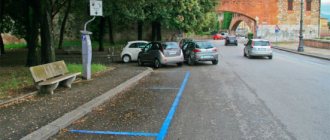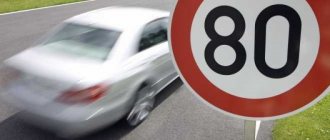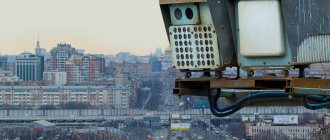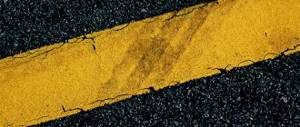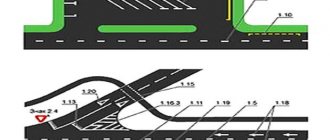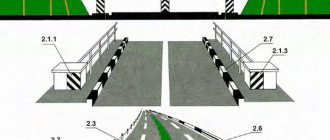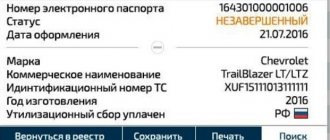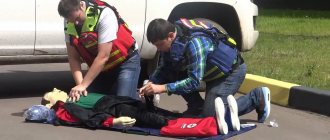"Waffle" marking
1.26 (color - yellow) - designates a section of the intersection that is prohibited from entering if there is a traffic jam ahead along the route that will force the driver to stop, creating an obstacle to the movement of vehicles in the transverse direction, with the exception of turning right or left in the cases established by these Rules . The marking can be used independently or in conjunction with road sign 1.35.
So, a new road marking 1.26 has been added to the traffic rules, which is a grid of diagonal yellow lines.
This markup is mainly intended for clarity. If there are markings, the driver can clearly see the boundaries of the zone within which he cannot stop. This allows you to assess even before entering the intersection whether it will be possible to leave it without violating the requirements of the rules.
Please note that the markings do not prohibit stopping when turning left or right. However, when moving straight or making a turn, you cannot stop there. This issue will be discussed in detail below.
What it is
“Waffle” markings – intersecting yellow stripes on the roadway. They indicate a section of the intersection where a motorist cannot enter if there is a traffic jam behind the intersection.
This markup is mainly intended for clarity. If there are markings, the driver can clearly see the boundaries of the zone within which he cannot stop. This allows you to assess even before entering the intersection whether it will be possible to leave it without violating the requirements of the rules.
To warn the driver about the presence of new markings at the intersection, a new sign will be installed in front of him - “Intersection Section”. It shows a yellow square with two intersecting diagonals. If this sign cannot be installed at the intersection itself, it will be placed at a distance of no more than 30 meters before the start of the “waffle iron”.
At the same time, it is not prohibited to stop at the markings when turning left or right, with the exception of a U-turn. A temporary stop at a waffle iron is allowed to yield to oncoming cars or to let a pedestrian or cyclist pass. However, the turn will be a violation if there is also a traffic jam outside the boundaries of the marking. Changes to traffic rules regarding the introduction of “waffle” markings will come into force on April 28, 2021.
Crossroads area sign
1.35 "Crossroads area" Designation of the approach to an intersection, the section of which is marked with markings 1.26 and which is prohibited from entering if there is a traffic jam ahead along the route that will force the driver to stop, creating an obstacle to the movement of vehicles in the transverse direction, with the exception of turning right or left in the cases established by these Rules.
Sign 1.35 is installed at the border of the intersection. If at complex intersections it is impossible to install a road sign at the border of the intersection, it is installed at a distance of no more than 30 meters from the border of the intersection.
In addition to the markings, a new “Intersection Section” warning road sign may also be used in 2021. This sign in itself does not prohibit or prescribe anything. It only tells the driver in advance that waffle markings await him at the intersection.
Please note that this sign is not installed in advance, but at the border of the intersection or at a short distance from it.
In addition, a sign “Photo and video recording” can be placed under this sign, indicating that violations at the intersection are recorded automatically.
Changes in traffic rules from April 28, 2021
Viewed 7,605
4-05-2018 Let's consider new changes in traffic rules that come into force on April 28, 2018
.
The rules introduce a new road sign “Intersection Section”
and corresponding road markings (
waffle
). Changes in traffic rules from April 28, 2021.
- Material navigation:
- New “Waffle” marking
- New sign "Crossroads"
- Changes to clause 13.2
- Fine for entering an intersection during a traffic jam
New “waffle” markup
Added markup
1.26
- designates a section of the intersection that is prohibited from entering if a traffic jam has formed ahead along the route, which will force the driver to stop, creating an obstacle to the movement of vehicles in the transverse direction, with the exception of turning right or left in the cases established by these Rules. The marking can be used independently or in conjunction with road sign 1.35.
This means that a new marking 1.26 appears in the traffic rules, which is a grid of diagonal yellow lines.
This marking is needed for clarity; with such markings, the driver can clearly see the boundaries of the intersection and will understand whether it is possible to enter the intersection or not.
People have already nicknamed this marking as “waffle” marking, because this marking has been tested for a long time in several large cities of Russia.
New sign "Crossroads"
Added a new sign
1.35 “Intersection Section”
Designation of the approach to the intersection, the section of which is marked with marking 1.26 and which is prohibited from entering if there is a traffic jam ahead along the route, which will force the driver to stop, creating an obstacle to the movement of vehicles in the transverse direction, with the exception of a turn to the right or left in the cases established by these Rules.
Sign 1.35 is installed at the border of the intersection. If at complex intersections it is impossible to install a road sign at the border of the intersection, it is installed at a distance of no more than 30 meters from the border of the intersection.
Changes to clause 13.2
Due to the addition of new markings, clause 13.2 of the traffic rules
:
Was
13.2. It is prohibited to drive to an intersection or intersection of roadways if a traffic jam has formed that will force the driver to stop, creating an obstacle to the movement of vehicles in the transverse direction.
It became
13.2. It is prohibited to drive to an intersection, the intersection of roadways or a section of an intersection marked by marking 1.26 if there is a traffic jam ahead along the route that will force the driver to stop, creating an obstacle to the movement of vehicles in the transverse direction, with the exception of turning right or left in the cases established by these Rules.
Fine for entering an intersection during a traffic jam
Part 1 of Article 12.13 of the Administrative Code:
1. Driving to an intersection or crossing a roadway in the event of a traffic jam that has forced the driver to stop, creating an obstacle to the movement of vehicles in the transverse direction,
- entails the imposition of an administrative fine in the amount of one thousand rubles.
We remind you that this fine existed before, but rarely anyone was fined for it, and now it will happen in automatic recording mode using cameras.
More from the section on changing traffic regulations.
Change in the Code of Administrative Offenses of May 1, 2021 New traffic police fines at railway crossings
New deadlines for retaking exams in the traffic police from April 1, 2021
Cancellation of exams at the circuit from April 1, 2021
Changes to traffic rules from March 1, 2021
Changes to traffic rules from April 8, 2021
Changes in traffic rules exam cards dated January 2, 2020.
How to drive through diagonal markings correctly?
13.2. It is prohibited to drive to an intersection or intersection of roadways if a traffic jam has formed that will force the driver to stop, creating an obstacle to the movement of vehicles in the transverse direction.
13.2. It is prohibited to drive to an intersection, the intersection of roadways or a section of an intersection marked by marking 1.26 if there is a traffic jam ahead along the route that will force the driver to stop, creating an obstacle to the movement of vehicles in the transverse direction, with the exception of turning right or left in the cases established by these Rules.
Note. The new clause 13.2 from the point of view of the Russian language was drafted incorrectly, but it was officially published in exactly this form.
Additions have also been made to clause 13.2 relating to the new markings. Now the requirement applies to 3 situations:
- going to an intersection;
- going to the intersection of roadways;
- exit to the section of the intersection marked with waffle iron markings.
In this case, it is prohibited to drive out only if the driver cannot pass through the intersection or markings without stopping. So if the road beyond the intersection is clear, you just need to drive through the markings.
Additionally, there are a few exceptions when turning left or right:
- Stopping when turning to give way to pedestrians or cyclists (clause 13.1 of the traffic rules);
- Stopping when turning left to give way to oncoming vehicles (clauses 13.4 and 13.12 of the traffic rules).
- Stopping when turning under the green arrow of a traffic light in an additional section, turned on simultaneously with the yellow or red main signal, in order to give way to vehicles moving from other directions (clause 13.5 of the traffic rules);
- Stopping when turning at an unequal intersection from a minor road in order to give way to vehicles moving on the main road (clause 13.9 of the traffic rules);
- Stopping when turning at an unequal intersection where the main road changes direction to give way to vehicles moving on an equivalent road on the right (clause 13.10 of the traffic rules);
- Stopping when turning at an intersection of equivalent roads in order to give way to vehicles approaching from the right (clause 13.11 of the traffic rules);
Again, pay attention to the two situations listed above. They allow the driver to stop at an intersection. However, there are several situations in which you cannot drive to the intersection of roadways :
- When driving straight, if there is a car behind the intersection (red in the picture) and there is not enough space for you.
- When turning right or left if there is a traffic jam behind the intersection. Unlike pedestrians, for whom you can stop, stopping during a traffic jam will result in a fine.
- Any stop at the markings when turning (even to let oncoming cars pass).
How to properly drive through an intersection with grid markings:
- If you plan to make a U-turn, it is better to abandon the maneuver. On a busy road it is almost impossible to do it without stopping.
- When driving straight or turning, first stop before the intersection and look in the direction you want to go. If cars continue to pass through the intersection, wait until they pass. After this, evaluate whether you have enough space behind the intersection. If yes, then start moving. If not, then wait until space becomes available.
- When driving through markings, do not stop, except in authorized cases (to let pedestrians pass when turning, to let oncoming people pass when turning left).
Correct passage of the intersection
Contains an advisory nature for drivers, supplemented paragraph 13.2, which was required by its new markings. The obligation to comply with the DPP applies to three situational situations.
They demand:
- correct exit to the intersection;
- correct crossing of roadways at intersections;
- correct exit to the location represented by the yellow lines.
The entry ban is observed when the car is unable to “pass” the intersection without an additional stop. It is allowed to maneuver if the driver needs to turn left or right. But this is considered an exception. Motorists should be especially careful here.
Situations arise in which it is prohibited to enter the intersecting parts of the intersection:
- The first case is when the car is driving straight and the driver notices that a traffic jam has formed on the side of the intersection in his direction.
- The second case is when turning right or left is prohibited due to the formation of a cluster of immobilized vehicles around the turns.
- The third case is that any U-turn is prohibited if there is a marking grid under the wheels of the car.
The above cases are perceived by traffic police officers as traffic violations. And violations result in significant fines.
Possible troubles when driving through new markings
Unfortunately, there are situations in which a driver can receive a fine despite the fact that he does not initially plan to break the rules. So, let's say the white car plans to turn left. To do this, he drives to the intersection and stops to let oncoming people pass:
When you stop, there is enough space behind the intersection to complete the maneuver. However, oncoming cars make a right turn, i.e. gradually occupy the entire space behind the intersection:
The driver of the white car has nowhere to leave the intersection, so he unwittingly finds himself violating the rules. At the same time, initially neither he nor the oncoming cars violated the rules.
However, this conflict has nothing to do with the introduction of new markup. It can happen at any intersection even if there are no yellow diagonal markings on it.
Is there a fine for waffle markings?
In some cases, a fine is imposed for hitting waffle markings. Below we will find out exactly when a driver can be punished for such an offense and what the amount of the monetary penalty is.
More on the topic: Fine for dirty and unreadable license plates
When was the fine introduced and how much is it?
The imposition of a fine for illegal entry into a “waffle” is regulated by part 1 of Article 12.13 of the Administrative Code, and the fine is 1,000 rubles. Please note that this article punishes not for the fact of entering the waffle marking itself, but for violating the rules for crossing intersections:
- Article 12.13 itself was introduced into the Code of Administrative Offenses in 2001, but in fact it was practically not applied due to the difficulty of recording such offenses by the traffic police.
- On April 28, 2021, amendments came into force, according to which the concept of waffle markings was introduced into the traffic rules. These amendments also required utility workers to mark intersections.
- In accordance with the law, regional authorities must soon install video recorders at all intersections with waffle markings to record violations. For example, in Moscow, the installation of cameras began on March 1, 2021.
What is the fine for?
A fine under Article 12.13 of the Code of Administrative Offenses is issued directly for violating the rules for crossing an intersection when there is a traffic jam. The object of the offense in this case is the safety of other traffic participants who are moving in a perpendicular direction.
When does responsibility come?
Administrative liability for traffic violations occurs in two main situations:
- You approach an intersection and see that there is a traffic jam ahead - but you still try to cross the intersection in the forward direction.
- While driving in a forward direction along the waffle iron, you stopped, which created an obstacle for other road users who were moving in a perpendicular direction.
Please note that other methods of going to the “waffle” are not subject to punishment under Article 13.12 of the Code of Administrative Offenses. For example, if there is a traffic jam in the forward direction, you can enter a waffle marking to make a turn or U-turn in accordance with standard traffic rules - in such a situation, no penalty will be applied, since such maneuvers do not pose a threat to the safety of cars moving in a perpendicular direction.
More on the topic: Fine for driving without a front or rear license plate
Possible fine for violation
For violation of yellow marking requirements, administrative liability is provided:
- intersection of a single line (solid or broken). In Moscow or St. Petersburg it is punishable by a fine of 3,000 rubles; in other regions of Russia the fine is 1,500 rubles. For parking in this area, the violator’s car may be towed to the impound lot;
- for ignoring the benefits of public transport that departs from a broken line (stop) - a fine of 500 rubles;
- ignoring traffic rules requirements to give way to pedestrians crossing the road along a yellow zebra crossing - a monetary penalty of 1,500 rubles;
- turning around or reversing in an area marked with a zigzag - 500 rubles;
- overtaking on a yellow zebra crossing, crossing a solid line dividing traffic flows - a monetary penalty of 5,000 rubles or deprivation of the right to drive for up to six months;
- leaving and stopping at a “waffle iron” at a prohibiting traffic light – a monetary penalty of 1,000 rubles;
- leaving and driving along the side of the road while ignoring the yellow line on the right edge - a fine of 1,500 rubles.
Do cameras record violations of road markings?
In modern conditions, there are two types of offenses related to crossing yellow markings, which are recorded by automatic cameras:
- Exit and drive along the side of the road marked with a yellow line. In this case, the type of shoulder does not matter: asphalt or unpaved. Thanks to the cameras, the number of drivers who avoid traffic jams on the side of the road is reduced. The fine for such a violation is 1,500 rubles.
- Departure and stop at the “waffle iron”. Stopping at the intersection is prohibited; markings of intersecting yellow lines are used to indicate the area where the restriction applies. In order for such a stop to be considered an offense, it is necessary to leave or not have time to leave the marked area after the activation of the prohibitory traffic light signal. The penalty for violators of this rule is 1000 rubles.
Yellow markings on the road - why they are needed
Don't be afraid when you have to drive where there are yellow markings on the road. We must remember that the rules are introduced for everyone’s safety, and not to complicate life. Having carefully studied the traffic rules, in particular, the meaning of these markings, everyone contributes to the development of a driving culture.
Double solid yellow markings
GOST has information that the white color is changing to yellow. This is done to improve visibility in winter. The value is no different from the white counterpart.
Single solid yellow marking
Multiple solid line values:
- separates moving traffic;
- in some cases it is used to limit traffic lanes in high-risk areas;
- used where traffic is prohibited;
- marks the location of areas intended for parking.
A solid stripe does not allow it to be crossed.
Single broken yellow marking
Separates moving vehicles. Intersects when it is necessary to overtake, turn or turn around. There is no broken line marking on the side of the road.
Marking 1.6 yellow
An increase in the length of the strokes and a decrease in the distance between them indicates that the broken line is coming to an end and a solid line will soon begin. Do not forget that in this case overtaking other vehicles is prohibited.
Double broken yellow markings
Located to indicate an area with reverse traffic. Such areas are regulated using special traffic lights.
Marking 1.11 yellow
Used in two cases:
- to separate traffic in one or the opposite direction in places where it is possible to change lanes only on one side;
- to show where it is allowed to move directly on the side where the broken line is located
The intersection is permitted to complete maneuvers such as overtaking and passing. Crossing from the side of the broken line is not prohibited.
Yellow markings on the road to prohibit stopping and parking
Located on the side of the road on the right, it says stopping and parking is prohibited. It is located either within the city along the curbs, or on intercity highways at the side of the road, along the edge of the road. In the place where the line is located, you cannot stop and park your car.
A broken yellow line along the side of the road indicates that parking is prohibited in that area only. You can make a stop within five minutes. Valid reasons include problems with transport, health, or other reasons that leave no other choice. Can be used with a "No Parking" sign. The principle of operation in this case is similar to that described above.
White and yellow pedestrian markings
Has no meaning other than white markings. It can be applied to both controlled and non-regulated pedestrian crossings.
Yellow zigzag markings on the road
Indicates places for public transport. Stopping is permitted only for boarding or disembarking passengers. Interference is not acceptable.
Waffle markings at an intersection
Applied to intersections for clarity. It is a square with a pattern resembling a wafer. It is prohibited to stop the vehicle. Makes it possible to understand whether it is possible to overcome the intersection if traffic ahead is difficult. If a controversial situation occurs, markings are used to determine whether there was a violation of traffic rules when crossing the intersection.
